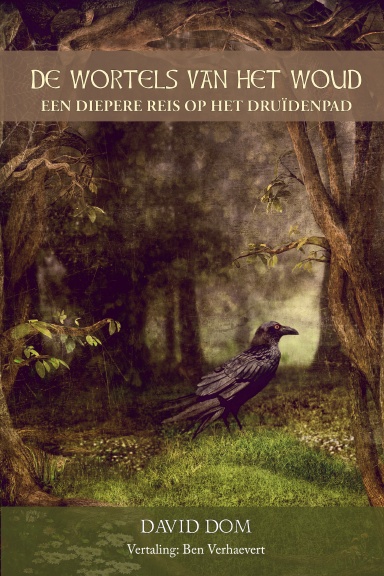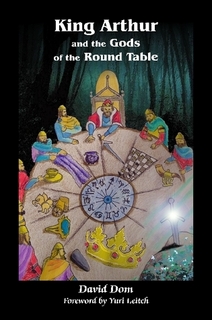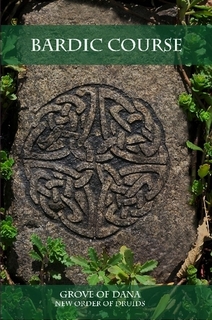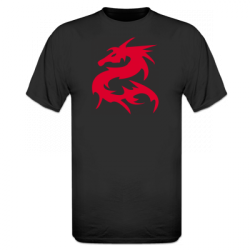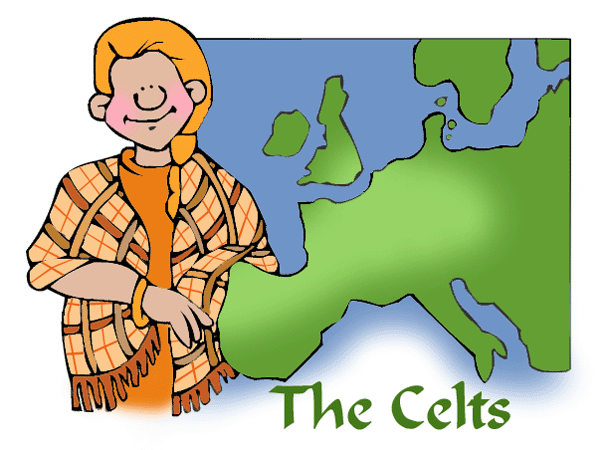
Who were the Iron Age Celts?
The Iron Age Celts were a tribe of people who lived all over Europe about two thousand years ago. At one time, you could find tribes of Celts in modern day Spain, France, northern Italy, and as far east as Russia. Around 500 BCE, the ancient Celts migrated and settled in modern day Ireland, Wales, Scotland, and the Isle of Man.
The Celts were a proud and honorable people. They were also very clean. The Celts are credited with the invention of soap! They were fierce warriors. But they never founded an empire. They never built cities. They lived in small farming communities. They loved music. They loved to boast. And they loved to make up stories, especially stories about the little people - fairies, elves, leprechauns. Their culture lives on today in music, story, and song.
What did they eat?
They lived on farms. They worked hard. All the people ate well. They had cheese, butter, milk, mead, honey, fish, pork, chicken, beef, lamb, vegetables, and breads and cereals made with wheat, barley, oats, and rye.
What did they wear?
The ancient Celts loved color. They used huge looms to weave richly dyed wool in colorful plaids. They made tunics to wear from some of their fabrics. Both men and women wore tunics. A man's tunic stopped at the knees. A woman's was floor length. They were both loosely gathered at the waist with a belt. Both men and women wore shawls over their tunics, wrapped loosely around their shoulders. They wore leather sandals.
Women wore their thick hair in braids decorated with beads. Men wore their swords and daggers at all times, for decoration and protection.
The Celts loved jewelry. Gold was hard to get. Silver was even harder to find. Jewelry made of gold or silver was highly coveted. But they made jewelry from many things, including horn, feathers, stones, bronze and beads. Both men and women were fond of wide necklaces worn like a collar around the neck. They decked themselves out with arm bands, bracelets, ankle bracelets, rings (lots of rings), and ornate belts. They fastened their cloaks with jewelry brooches and ornate pins. They loved glitter and color.
How did they live?
The Fine: The smallest group in Celtic society was the Fine. A fine is an extended family group that included grandparents and parents and their kids, and could include aunts, uncles, cousins and their kids. The individual was not important. The fine was a unit, and was treated like one person. Everything belonged to the fine. A person could not break the law. If a member of a fine broke the law, the fine was responsible. By the same token, there was no such thing as individual glory. The fine was victorious.
The Clan: The next step up was the clan. Each clan was made up of several fines. In some cases, a fine would be so large that it was a clan in itself. You were part of a clan for life and beyond. Clans went back many generations.
Each clan had a leader. You did not inherit leadership from your father. Any male could be chosen as long as he had a blood relationship to the clan. Each clan expected certain things of their leaders. Leaders had to be strong warriors. They had to be able to work out disagreements with other clans and conduct trade and raids on neighboring clans. Most importantly, they had to be rich enough to throw really good festivals.
Festivals: Festivals were very important to the ancient Celts. Festivals were held for many reasons - to honor their gods, to cement clan relationships, to provide a place for the young to meet and marry, and to provide recreation for members of the clan, rich and poor. Some festivals were just for men, others were just for women. Most festivals were for everyone. Festivals were common. At festivals, people competed in contests of skill and strength. They sang and listened to music. There was a great deal of drinking. The Celts made a honey-based beer called mead. Fights would break out on occasion. And always, at festivals, or any time, the ancient Celts spent a great deal of time boasting and bragging and telling stories.
The Celts were loyal to their clans: Clans stuck together. Members of a clan supported each other. That is one of the major reasons the Celts never developed an empire. To have an empire, you need a central government, with one leader who ruled all the people. The ancient Celts would never had allowed this. Their loyalty was to their fine and to their clan.
Stories: Anytime was a good time for a celtic tale. The ancient Celts told stories of battle and victory, stories about their children, stories about funny things that had happened, stories about their many gods and goddesses, and of course, stories about the little people.
Music: Music, both vocal and instrumental, was very important to the ancient Celts. Each night, as they sat around the campfire, they played music on instruments they made. Kids learned on their parents instruments. When a child reached the age of 14 or 15, they started to make their own musical instrument. It was something all Celts did, whatever their clan. Instruments included flutes, whistles, the bagpipes, the Celtic harp, a drum played with a two-headed stick, and the fiddle.
Bards: Music was so important to the ancient Celts that a group evolved called the Bards. Brads were wandering singers, storytellers, and poets. If a bard made up a really nasty story about you, and put it into the form of a song or a story, what that bard was saying would be believed. In time, the Bards became as powerful as the druids (priests and teachers). The bards could destroy your reputation with a song.
Dancing: Irish jig, Scottish reels, any old thing. Dancing, like music, was a joyous activity to the ancient Celts. As long as it was lively and athletic, they loved it.
Who's Who:
Inside each clan, there were three major groups of people. At the top were the nobles, which included warrior leaders and landowners. In the middle were the artisans and druids (bards, priests, teachers). At the bottom were the common people, the peasants. Whatever their position in society, all people lived well. Everyone in Celtic society belonged to a clan. Everyone belonged to a fine. And everyone had a job to do.
Nobles:
The Nobles were landowners. They were warrior leaders. The nobles had slaves occasionally, but these were people captured in war. Most of the work was done by the peasants, and that left the nobles lots of free time.
Noble Men: When noble men were not off fighting, they were farmers. They spent time playing fighting games, games of chance, and board games. They hunted and swam and fished. They conducted trade.
Noble Women: What a noble woman could and could not do was clearly spelled out, although it varied from clan to clan. A noble woman could own property. She could choose her own husband. Women could become warriors, but few chose to do so. Most ran the household, raised the children, and spent a great deal of time on their personal appearance, weaving jewerly into their braids.
Kids: The nobles sent their kids off at quite an early age to live with another clan for training and education. Training could take years. This was one way the ancient Celts developed close ties between various clans. It was called fostering. Sometimes kids were sent away to their mother's clan, but they could be sent to any clan. Some kids became more loyal to their foster clan than they were to their blood clan. After all, they grew up there. Still, in times of war, if things went wrong, kids could be held by their foster clan for ransom. The foster clan might even threaten to kill the kids in their care unless they got their way. It was an odd system, but it was the system of the ancient Celts.
Marriage: When a woman married, she joined her husband's clan. You were always a member of your own clan. You never escaped that obligation and membership. But your husband's clan took precedence.
Artisans:
 |
Celtic art is full of patterns and spirals and animals and color. Like their daily life, their art was lively. They made colorful jewelry, fabulous fabrics, beautiful pottery, shapely figurines of bronze and gold, strong wheels for carts and wagons and strong weapons out of iron.
Artisans were highly respected. They did not owe any military service to the nobles. They did not work in the fields. If they were talented, they gained wealth and comfort. They were free to travel and sell their goods to other clans. Artists were appreciated and encouraged. The Celtic cross, popular for over a thousand years, was not designed by the Celts until the early middle ages. |
Peasants:
The peasants were free to come and go. Unless they married out of their clan, or studied to become an artisan, a bard, a druid priest, or a warrior, they had no reason to venture very far from their homestead.
Each fine had several buildings that they shared. One building called a roundhouse was a big home made of straw and mud. This is where the members of a fine slept and sheltered from the elements. The Celts did not have chairs or furniture other than a scattering of low tables. They slept on furs or mats. They sat on the floor. The biggest piece of furniture in each home would be the large looms where fabrics were woven all winter long.

Roundhouses were built of straw and mud bricks
They also built several outbuildings that they used to cook food, tan leather, store food, and shelter their animals. Again, these outbuildings were shared by everyone in the fine. Sometimes, these buildings were shared by several fines. These were farming communities. But that's about as big as a single "village" grew. The ancient Celts did not build cities. It was not their way.
Each homestead (group of buildings) was surrounded by the fields in which they grew crops. Beyond that, at the edge of their boundary, the fine built a short wall made of rocks. This wall was used to define the fields that belonged to the fine, and also acted as some protection from attack.
In times of attack from another Celtic tribe or from the Romans, the fine retreated to a hill fort, a home built on top of a hill, surrounded by enclosure of stakes. Hill forts were huge things that could hold everyone in times of attack. They builts huts and cattle enclosures standing ready. But the Celts did not like to live so closely together. To them, the hill fort was crowded, because everyone was there, but it was only a temporary retreat.

Peasant Men: Along with hunting and fishing, the men did the heavy labor on the farms. They were wonderful farmers. The Celts invented a reaping machine, an invention that was copied by the ancient Romans. The reaping machine let them harvest more rapidly. With the reaper, they were far less likely to lose crops to an early frost. It also saved on labor. They stored grain in pits for the winter.
Peasant Women: The women gathered berries and other foods that could be harvested. They cooked and cleaned and sewed and looked after the children.
Kids: The girls helped their mothers, the boys helped their fathers. At night, everyone would collect in the big home that served them all. Around age 15, both boys and girls began to think of marriage. Most would marry someone they met at a clan festival. The tallest boys might be selected to train as warriors. Some might learn an artisan skill. Most would be farmers. With their free time, kids would play war games. Also popular was a game they played similar to field hockey.
Campfire Conversations: In the evening, everyone in the fine would gather around a central campfire. Every few day, as they gathered around the campfire, they would review what had happened in the last few days. If you had a problem with someone, that is when you would bring it up. There were no secrets. Problems would be discussed, resolved, and forgotten. Each fine, and each clan, knew they were on the same side. They supported each other.

Celtic Religion:
The ancient Celts believed in an Otherworld. The Otherworld was the home of many gods and goddess. It was a place of joy, where feasts were always happening. The Otherworld was NOT a heaven. It was NOT a reward for doing something good on earth. The Celts believed that everyone entered the Otherworld when they died.
Celtic Tombs: Like the ancient Egyptians, the ancient Celts wanted their dead to have nice things with them. They wanted them to have food for the trip. They buried their dead in tombs. Their tombs were not huge things like the Egyptian pyramids. But they were the size of a large room. The walls were decorated with drawings of earth gods, sun gods, various spirits, and scenes of battle and daily life. They never placed living people or animals inside a tomb. Instead, they tucked little figures of people cooking and hunting. One tomb was found with a full size four-wheel wagon in it, and a full size bronze kettle for cooking.
Waterfalls were one of the many doorways to the Otherworld: Natural waterfalls, especially small ones, were believed to have healing power. To the ancient Celts, they were entrances to the Otherworld. Gifts were left by waterfalls for the gods. Some gifts were even tossed down wells or into springs. If you were injured, you might place something in a stream to help you heal. If your leg was injured, you could carve a wooden leg and place it in a stream. It did not always work, but the Celts remained great believers anyway in the power of the little spirits and gods whom they believed lived in steams and ponds and waterfalls.
The ancient Celts believed in many gods and goddesses. Every tree, every bush, every flower, everything had a little deity living in it. Some of their gods and goddesses were extremely powerful. But most were little dieties. The ancient Celts did not worship their gods. They did not go to church. Instead, they left little offerings all over the place. Each fine had their own special little deities. Each clan had theirs. Unlike the ancient Greeks, the gods of the ancient Celts did not trouble themselves with the affairs of men, unless they were asked to do so.
Sacred animals: The Celts believed in omens. Birds, especially, were believed to be able to carry messages between the living world and the Otherworld. Many animals were given special powers that could only be understood by a Celtic priest - the druids. Some animals were hunted for food. Hunting wild boar was considered a great sport.
Druids:The Celts believed that demons and spirits were everywhere. They believed that omens and portents were everywhere. They counted on their priests, the druids, to keep them safe from trouble. The druids were responsible for all religious rituals, because the only person who could talk to a god was a druid.
The druids were the soothsayers, the seers, the teachers, the doctors, the philosophers, and the lawyers in Celtic society. To become a druid, you had to study with the druids for at least twenty years. The druids had their own universities. There was a lot to learn. The Celtic people went to the druids for everything. If a child was sick, you went to your druid, who might cure the child with medicine they made from a plant. If two fines were having a fight over a boundary, a druid would decide who was right and who was mistaken. If a raven flew over a homestead, the fine might want to know what it meant. To find out, you asked the druids.
Druids were members of a clan like everyone else, highly respected, and powerful. Druids decided who could get married, who inherited, and established the honor price for each individual in their clan.
Honor Price: Your honor price was your worth. If you accidentally injured or killed someone, your fine had to pay the honor price of the person you hurt. If more than one person was involved, the bill was split equally between all the guilty parties. Monies went to the injured person's fine.

Celtic Warriors:
The warriors were not a social class of people. All the ancient Celtic people were warriors if they needed to be. Although most women stayed home, looking after the crops and the children, when their men went off to war, women could choose to train and fight as warriors if they wished. There were warrior schools. A couple of those schools were run by women. But they were the exceptions. Most of the warriors were well trained men.
You might hear tales of warriors running naked into battle with only a shield and a sword for protection. There was one tribe that painted their body blue and ran naked into battle. But most warriors wore some protection. The nobles wore chain mail, and carried a shield and a sword. Peasant's shields might be made of wood instead of iron, but they were covered in leather. Their weapons were made of iron.

Celtic warriors used many tricks to scare their opponents. The Celts were naturally tall, with blonde or red hair. They rode horses into battle, which not only gave them a fighting advantage, but made them look even taller. Many warriors wore bronze or wood helmets shaped with two horns, that made them look taller yet.
Men put lime in their hair before a battle. Lime burns and acts as a bleach. It lightened their hair so it was even more blonde. The lime also stiffened as it dried. This gave the men a protective glowing crown. Just before entering a battle, musical horns were blown. Men beat their swords against their shields and screamed battle cries and insults at their opponents.
The Celts like to chop off the head of the leader of their enemies. That head was cured and rubbed with oil, and nailed over the doorway, somewhat like modern hunters do with deer heads.
If you were facing an army of Celtic warriors, you would see a seemingly endless field of tall, screaming scary looking god-like creatures with lime spiked hair glowing brightly in the sun, and severed heads hanging from their belts and wagons. It would have been a most terrifying sight. The Celts were not only fierce fighters. They looked and sounded like fierce fighters. They often won, sometimes without even entering into battle. Between trading and raiding, the Celts soon became rich.
It did not take long before the Celts had pretty much taken over all of Ireland, Scotland, Wales, and the Isle of Man. The other tribes in these areas either moved away, were killed in battle, or joined the Celts. When the ancient Celts ran out of other tribes to fight, they began to fight each other. Close relationships between clans did not stop them from raiding each other - stealing cattle and other wealth. This led to many a battle.
Various clans rarely went into full battle with each other. What they would do is show up in full battle dress at a pre-arranged location. Each side would line up at some distance from the other, and scream insults at each other. Each side made as much racket as they could. They beat their shields and screamed and shouted and blew horns. Finally, when they had just about exhausted themselves from all their noise, each side would send a predetermined number of men - one or two or a handful - forth to fight for them. These fights were usually to the death. The outcome of the fight determined who was the winner. Goods or lands were distributed accordingly. Everyone went home, to fight another day.
The ancient Celts had always fought as a clan, not as a people. Clans might team up against another clan or two, but they had never banded together totally to defeat one common foe. When the Roman army arrived, the Celts did not band together to fight them. The well organized Roman army found them easy prey. The Romans did not wipe out the Celts. But they did rule the Celts for many years.

A written language: The Celts did not have a written language until nearly the Middle Ages. Much of what we know about the Iron Age Celts comes to us from their oral legends and myths.
Gifts the ancient Celts gave the world: Soap, Irish linen, Scottish plaids, Irish jigs, Scottish reels, Welsh dragons, the fiddle, the bagpipe, the Celtic harp, and many wonderful folk and fairy tales, including tales of the goddess Epona (pictured below), the goddess of horses (and all animals), and a holder of a key to the Otherworld.
From: http://celts.mrdonn.org/dailylife.html















